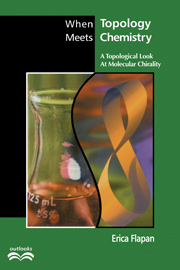3 - Möbius Ladders and Related Molecular Graphs
Published online by Cambridge University Press: 05 June 2012
Summary
The molecular bond graph of a three-rung Möbius ladder was the first molecular graph that required sophisticated topological machinery to prove that it could not be deformed to its mirror image (see Figure 3.1). Because of its form as a Möbius strip, this molecule appeared to be distinct from its mirror image. There was also experimental evidence indicating that the molecule was chemically chiral (Walba, 1983). However, because the molecule was a ladder rather than a strip and it was both long and flexible, in theory it might be able to deform itself to its mirror image in some nonobvious way. Walba conjectured that the molecular bond graph of the Möbius ladder was, in fact, topologically chiral, although he could not prove it. In this chapter we shall explain Jon Simon's proof (Simon, 1986) that the embedded graphs representing the molecular Möbius ladders with three or more rungs are topologically chiral. Then we will prove that every embedding of a Möbius ladder with an odd number of rungs greater than two is necessarily topologically chiral. In contrast, recall from Chapter 1 that every Möbius ladder with an even number of rungs has a topologically achiral embedding. Finally, we will discuss the topological chirality of some molecular graphs that are related to Möbius ladders.
Chirality of Möbius Ladders
In order to consider the general form of the graph of a Möbius ladder, we would like to omit all of the vertices of valence 2.
- Type
- Chapter
- Information
- When Topology Meets ChemistryA Topological Look at Molecular Chirality, pp. 69 - 109Publisher: Cambridge University PressPrint publication year: 2000



